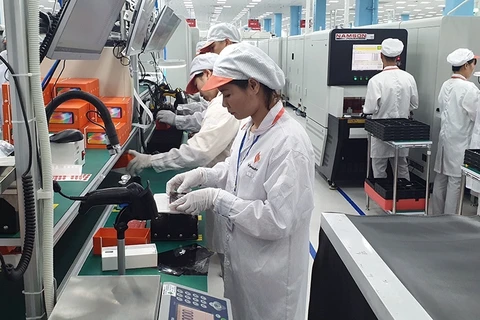 By 2030, the value proportion of high-tech industrial products in Vietnam's processing and manufacturing industry will reach at least 45%.(Photo: VNA)
By 2030, the value proportion of high-tech industrial products in Vietnam's processing and manufacturing industry will reach at least 45%.(Photo: VNA) Hanoi (VNA) - Deputy Prime Minister Vu Duc Dam has signed Decision No. 569/QĐ-TTg dated May 11 issuing a strategy for scientific-technological development and Innovation until 2030.
DECISION
Promulgating the Strategy for Science, Technology and Innovation Development until 2030
THE PRIME MINISTER
Pursuant to the Law on Organisation of the Government dated June 19, 2015; the Law on amendments and supplements to some articles of the Law of Organisation of the Government and the Law on Organisation of the Local Administration dated November 22, 2019;
Pursuant to the Law on Science and Technology dated June 18, 2013;
At the proposal of the Minister of Science and Technology.
DECIDES:
Article 1. Promulgating the Strategy for Science, Technology and Innovation Development until 2030 (hereinafter referred to as “the Strategy”), with the following contents:
I. VIEWPOINTS ON SCIENCE, TECHNOLOGY AND INNOVATION DEVELOPMENT
1. Developing science, technology and innovation is the top national policy and plays a strategic breakthrough role in the new period; is the main motivation to promote growth, create breakthroughs in productivity, quality and efficiency; is the decisive factor in the improvement of the competitiveness of the nation, socio-economic sectors, localities and enterprises; is the stepping stone for the implementation of national digital transformation; and significantly contributes to improving the people's life, promoting sustainable development and safeguarding national defence and security.
2. Developing social sciences and humanities, natural sciences, technical sciences and technology in a concerted, interdisciplinary and focus-driven manner. Developing the national innovation system and regional and sectoral innovation systems, in which enterprises are the centre, research institutes and universities are strong research bodies, and the State issues orientations, coordinates and creates a favourable regulation and policy environment for effective operations of the whole system.
3. Harmoniously and effectively combining the development of internal capacity with the optimisation of opportunities and external resources. Prioritising the acquisition, absorption, mastery and fast application of advanced scientific and technological advances in the world, in particular, proactively and actively approaching and thoroughly capitalising on the opportunities and achievements of the Fourth Industrial Revolution. Promoting applied research that bring about socio-economic benefits while at the same time, paying attention to application-oriented basic research towards inventing, mastering and competing in technology in the key areas that Vietnam has demand, potential and advantages.
II. OBJECTIVES OF SCIENCE, TECHNOLOGY AND INNOVATION DEVELOPMENT
1. Overall objectives
By 2030, science, technology and innovation will be firmly developed, truly become motivation for growth, and make a decisive contribution to the development of Vietnam into a developing country with modern industry and upper-middle income; contribute to the comprehensive development of culture, society and people, the safeguarding of national defence - security, environmental protection, sustainable development and improvement of Vietnam's international stature and reputation. The capacity and level of science, technology and innovation will reach advanced levels in many key areas, making Vietnam one of the best performers among upper-middle-income countries. Enterprises’ technology and innovation level and capacity will surpass the global average. Some areas of science and technology will reach international level.
2. Specific objectives:
a) Improving science, technology and innovation’s contribution to economic growth via scientific research and technological development by research institutes and universities, technological innovation and enhancement of governance and organisation capacity in enterprises. Total factor productivity (TFP)’s contribution to economic growth will be above 50%.
b) Science, technology and innovation will play an important role in the development of spearhead industries, with the processing and manufacturing industry as a focus, to significantly help with restructuring the economy in a modernity-oriented manner and turning Vietnam into a country with modern industry by 2030. Actively and effectively participating in and making use of trade advantages and opportunities of the Fourth Industrial Revolution. By 2030, the proportion of the value of high-tech industrial products in the processing and manufacturing industries will reach at least 45%.
c) Science, technology and innovation will significantly contribute to the building and development of cultural and social values and people of Vietnam; provide scientific ground for the making of guidelines and policies on national development; and help maintain the Human Development Index (HDI) at over 0.7.
d) The Global Innovation Index (GII) will be improved continuously, among the top 40 in the world.
dd) By 2025, investment in science and technology will reach 1.2% - 1.5% of GDP, of which total national expenditure on scientific research and technological development will be equivalent to 0.8% - 1% of GDP, and the society's contribution to scientific research and technological development will account for 60% - 65%. By 2030, investment in science and technology will reach 1.5% - 2% of GDP, of which total national expenditure on scientific research and technological development will be equivalent to 1% - 1.2% of GDP, and the society’s contribution to scientific research and technological development will make up 65% - 70%.
e) By 2025, human resources for scientific research and technological development (full time) will reach 10 people per ten thousand people, and by 2030, 12 people per ten thousand people. In particular, focus will be put on the development of human resources in enterprises.
g) The system of science and technology organisations will be restructured in line with the orientation of prioritising development of the nation, industries and areas toward self-reliance, connectivity, and approach to international standards. By 2025, 25 - 30 science and technology organisations will be given regional and international rankings, and by 2030, the figure will be 40 - 50.
h) By 2030, the number of enterprises meeting the criteria for science and technology enterprises and the number of innovative start-ups will double the figures in 2020; the rate of businesses with innovation activities will account for 40% of the total.
i) The number of international publications will increase by an annual average of 10%. The number of applications for patent registration and patent protection titles will increase 16% - 18% per year on average; the number of applications for protection of plant varieties will increase by an annual average of 12% - 14%, of which 10% - 12% will be filed abroad; the rate of patents that are commercially exploited will reach 8% - 10% of the total patents granted protection titles. Developing the national quality infrastructure (NQI) that meets the requirements for strong international integration in terms of standards, measurement and quality, among the top 50 in the world.
(to be continued)























